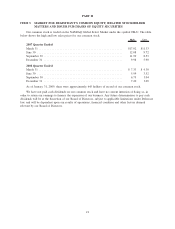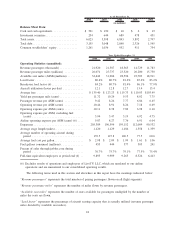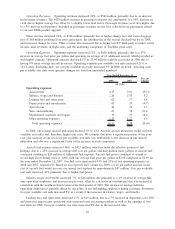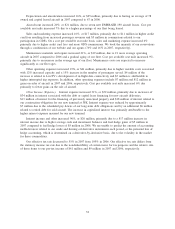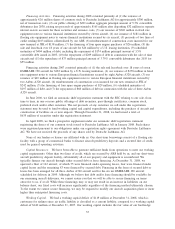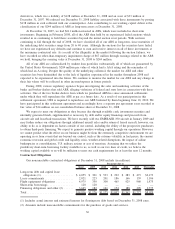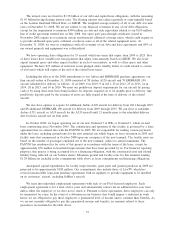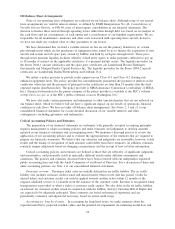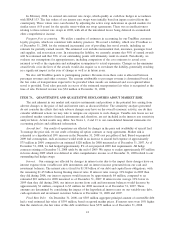JetBlue Airlines 2008 Annual Report Download - page 40
Download and view the complete annual report
Please find page 40 of the 2008 JetBlue Airlines annual report below. You can navigate through the pages in the report by either clicking on the pages listed below, or by using the keyword search tool below to find specific information within the annual report.
yield due to higher average fare offset by a slightly lower load factor. Passenger revenues were also higher due
to a 24% increase in departures.
Other revenue increased 47%, or $66 million, primarily due to higher change fees and excess baggage
fees of $28 million resulting from more passengers and higher rates. Other revenue also increased due to
higher LiveTV third-party revenues of $12 million, rental income of $8 million, mail revenues of $3 million
and the marketing component of TrueBlue pint sales of $3 million.
Operating Expenses. Operating expenses increased 20%, or $437 million, primarily due to operating an
average of 21 additional aircraft, which provided us with higher capacity, and a 5% increase in average fuel
price per gallon. Operating capacity increased 12% to 31.9 billion available seat miles in 2007 due to having
20% more average aircraft in-service. Our increase in capacity was partially offset by a 3% reduction in
available seat miles due to the removal of a row of seats on our Airbus A320 aircraft in the first quarter of
2007. Operating expenses per available seat mile increased 7% to 8.38 cents. Excluding fuel, our cost per
available seat mile increased 5% in 2007. In detail, operating costs per available seat mile were (percent
changes are based on unrounded numbers):
2007 2006
Percent
Change
Year Ended December 31,
(in cents)
Operating expenses:
Aircraft fuel ................................... 2.91 2.63 10.7%
Salaries, wages and benefits ....................... 2.03 1.94 5.1
Landing fees and other rents ....................... .57 .55 2.5
Depreciation and amortization ...................... .55 .53 4.2
Aircraft rent ................................... .39 .36 7.2
Sales and marketing ............................. .38 .36 4.3
Maintenance materials and repairs ................... .33 .30 8.8
Other operating expenses.......................... 1.22 1.15 6.2
Total operating expenses ........................ 8.38 7.82 7.1%
In 2007, our average stage length declined 5% to 1,129 miles due to increased operation of the
shorter-range EMBRAER 190 aircraft. A shorter average stage length results in fewer available seat miles and,
therefore, higher unit costs. We estimate that more than half of the year-over-year increase in our total cost per
available seat mile was attributable to the decrease in our average stage length and also was a significant
factor of the increase in each component.
Aircraft fuel expense increased 24%, or $177 million, due to 67 million more gallons of aircraft fuel
consumed resulting in $133 million of additional fuel expense and a 5% increase in average fuel cost per
gallon, or $44 million. Aircraft fuel prices remained at or near historically high levels in 2007, with our
average fuel price per gallon at $2.09 compared to $1.99 for the year ended December 31, 2006. Our fuel
costs represented 35% and 34% of our operating expenses in 2007 and 2006, respectively. Our fuel
consumption per block hour decreased 3% due to utilization of the lighter EMBRAER 190 aircraft and various
fuel conservation initiatives. Cost per available seat mile increased 11% primarily due to higher fuel prices
and decreased stage length.
Salaries, wages and benefits increased 17%, or $95 million, due primarily to changes in our employee
retirement plan, increases in our 2007 pilot pay rates, increased profit sharing, and overtime pay resulting from
the weather-related events in the first quarter of 2007. Specifically, we recorded $20 million of profit sharing
in 2007 compared to $3 million in 2006. Cost per available seat mile increased 5% as a result of the 2007
pilot pay increases and profit sharing.
Landing fees and other rents increased 14%, or $22 million, due to a 24% increase in departures over
2006 and increased airport rents associated with opening five new cities in 2007. Cost per available seat mile
increased 3% due to the decrease in average stage length.
31


